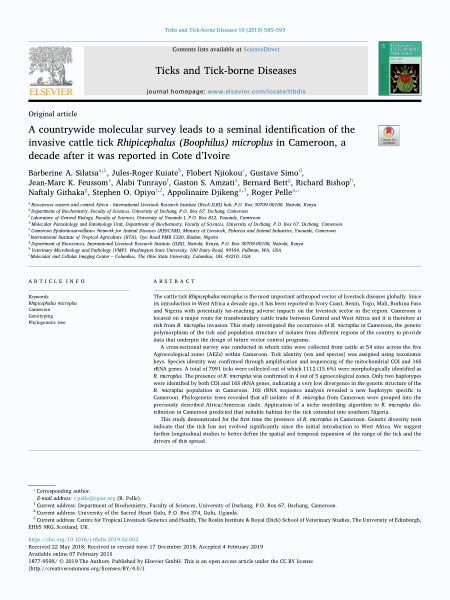A countrywide molecular survey leads to a seminal identification of the invasive cattle tick Rhipicephalus (Boophilus) microplus in Cameroon, a decade after it was reported in Côte d’Ivoire
Abstract
The cattle tick Rhipicephalus microplus is the most important arthropod vector of livestock diseases globally. Since its introduction in West Africa a decade ago, it has been reported in Ivory Coast, Benin, Togo, Mali, Burkina Faso and Nigeria with potentially far-reaching adverse impacts on the livestock sector in the region. Cameroon is located on a major route for transboundary cattle trade between Central and West Africa and it is therefore at risk from R. microplus invasion. This study investigated the occurrence of R. microplus in Cameroon, the genetic polymorphism of the tick and population structure of isolates from different regions of the country to provide data that underpin the design of future vector control programs.
A cross-sectional survey was conducted in which ticks were collected from cattle at 54 sites across the five Agroecological zones (AEZs) within Cameroon. Tick identity (sex and species) was assigned using taxonomic keys. Species identity was confirmed through amplification and sequencing of the mitochondrial COI and 16S rRNA genes. A total of 7091 ticks were collected out of which 1112 (15.6%) were morphologically identified as R. microplus. The presence of R. microplus was confirmed in 4 out of 5 agroecological zones. Only two haplotypes were identified by both COI and 16S rRNA genes, indicating a very low divergence in the genetic structure of the R. microplus population in Cameroon. 16S rRNA sequence analysis revealed a new haplotype specific to Cameroon. Phylogenetic trees revealed that all isolates of R. microplus from Cameroon were grouped into the previously described Africa/Americas clade. Application of a niche modelling algorithm to R. microplus distribution in Cameroon predicted that suitable habitat for the tick extended into southern Nigeria.
This study demonstrated for the first time the presence of R. microplus in Cameroon. Genetic diversity tests indicate that the tick has not evolved significantly since the initial introduction to West Africa. We suggest further longitudinal studies to better define the spatial and temporal expansion of the range of the tick and the drivers of this spread.

